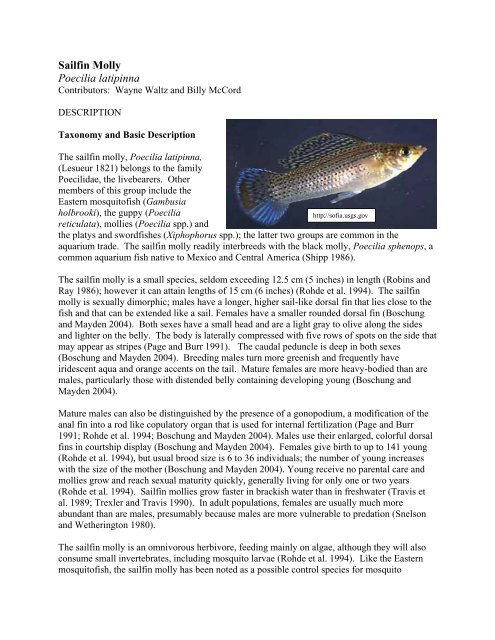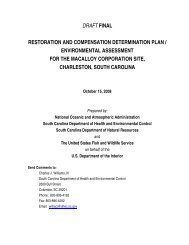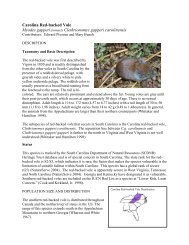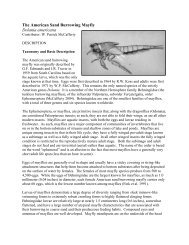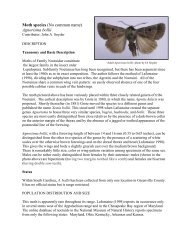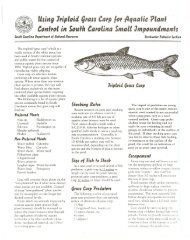Sailfin Molly Poecilia latipinna - South Carolina Department of ...
Sailfin Molly Poecilia latipinna - South Carolina Department of ...
Sailfin Molly Poecilia latipinna - South Carolina Department of ...
Create successful ePaper yourself
Turn your PDF publications into a flip-book with our unique Google optimized e-Paper software.
<strong>Sailfin</strong> <strong>Molly</strong><br />
<strong>Poecilia</strong> <strong>latipinna</strong><br />
Contributors: Wayne Waltz and Billy McCord<br />
DESCRIPTION<br />
Taxonomy and Basic Description<br />
The sailfin molly, <strong>Poecilia</strong> <strong>latipinna</strong>,<br />
(Lesueur 1821) belongs to the family<br />
Poecilidae, the livebearers. Other<br />
members <strong>of</strong> this group include the<br />
Eastern mosquit<strong>of</strong>ish (Gambusia<br />
holbrooki), the guppy (<strong>Poecilia</strong><br />
http://s<strong>of</strong>ia.usgs.gov<br />
reticulata), mollies (<strong>Poecilia</strong> spp.) and<br />
the platys and swordfishes (Xiphophorus spp.); the latter two groups are common in the<br />
aquarium trade. The sailfin molly readily interbreeds with the black molly, <strong>Poecilia</strong> sphenops, a<br />
common aquarium fish native to Mexico and Central America (Shipp 1986).<br />
The sailfin molly is a small species, seldom exceeding 12.5 cm (5 inches) in length (Robins and<br />
Ray 1986); however it can attain lengths <strong>of</strong> 15 cm (6 inches) (Rohde et al. 1994). The sailfin<br />
molly is sexually dimorphic; males have a longer, higher sail-like dorsal fin that lies close to the<br />
fish and that can be extended like a sail. Females have a smaller rounded dorsal fin (Boschung<br />
and Mayden 2004). Both sexes have a small head and are a light gray to olive along the sides<br />
and lighter on the belly. The body is laterally compressed with five rows <strong>of</strong> spots on the side that<br />
may appear as stripes (Page and Burr 1991). The caudal peduncle is deep in both sexes<br />
(Boschung and Mayden 2004). Breeding males turn more greenish and frequently have<br />
iridescent aqua and orange accents on the tail. Mature females are more heavy-bodied than are<br />
males, particularly those with distended belly containing developing young (Boschung and<br />
Mayden 2004).<br />
Mature males can also be distinguished by the presence <strong>of</strong> a gonopodium, a modification <strong>of</strong> the<br />
anal fin into a rod like copulatory organ that is used for internal fertilization (Page and Burr<br />
1991; Rohde et al. 1994; Boschung and Mayden 2004). Males use their enlarged, colorful dorsal<br />
fins in courtship display (Boschung and Mayden 2004). Females give birth to up to 141 young<br />
(Rohde et al. 1994), but usual brood size is 6 to 36 individuals; the number <strong>of</strong> young increases<br />
with the size <strong>of</strong> the mother (Boschung and Mayden 2004). Young receive no parental care and<br />
mollies grow and reach sexual maturity quickly, generally living for only one or two years<br />
(Rohde et al. 1994). <strong>Sailfin</strong> mollies grow faster in brackish water than in freshwater (Travis et<br />
al. 1989; Trexler and Travis 1990). In adult populations, females are usually much more<br />
abundant than are males, presumably because males are more vulnerable to predation (Snelson<br />
and Wetherington 1980).<br />
The sailfin molly is an omnivorous herbivore, feeding mainly on algae, although they will also<br />
consume small invertebrates, including mosquito larvae (Rohde et al. 1994). Like the Eastern<br />
mosquit<strong>of</strong>ish, the sailfin molly has been noted as a possible control species for mosquito
populations (FLMNH 2005). The sailfin is at the lower end <strong>of</strong> the food web and serves as food<br />
for insects, fishes, reptiles, amphibians and mammals (FLMNH 2005). In open systems, the<br />
sailfin molly is consumed by many larger fishes; in closed pools, ditches, ponds and<br />
impoundments the sailfin molly provides food for wading birds. <strong>Sailfin</strong> mollies thrive best in<br />
organically enriched, isolated pools or ditches where there are few other fish species and where<br />
there is sufficient vegetation to provide cover from other predators (Minckley 1973; J.W.<br />
McCord, SCDNR, pers. obs.).<br />
Status<br />
According to Warren et al. (2000), the sailfin molly is stable throughout its range. However,<br />
almost no data exists on the abundance and distribution <strong>of</strong> this species in <strong>South</strong> <strong>Carolina</strong>.<br />
McGovern and Wenner (1990) report this species in low numbers in samples from<br />
impoundments where salinity ranged from 0 to 31.9 ppt (parts per thousand). It can be abundant<br />
in specialized habitats, such as brackish pools, ditches, impoundments and ponds. Because <strong>of</strong> its<br />
tolerance to low dissolved oxygen, the sailfin molly has the potential as an indicator species to<br />
show impacts from pollution as shown by acute toxicity to pesticides and other chemicals. The<br />
absence <strong>of</strong> this species from its preferred habitats should indicate a major concern for pollution<br />
at levels at which most other aquatic species would also be intolerant. It could also serve as a<br />
natural control mechanism for larval mosquitoes.<br />
POPULATION DISTRIBUTION AND SIZE<br />
In the wild, the sailfin molly is considered a temperate species ranging from Cape Fear, North<br />
<strong>Carolina</strong> in the Atlantic to Veracruz, Mexico in the Gulf <strong>of</strong> Mexico (Page and Burr 1991; Rohde<br />
et al. 1994). Non-indigenous populations are also present in the western United States and in<br />
other countries (Rohde et al. 1994). According to Rohde et al. (1994), the sailfin molly is<br />
restricted primarily to cordgrass (Spartina spp.) marshes in the <strong>Carolina</strong>s but occurs further<br />
inland in states like Florida, Louisiana and Texas. In Florida, it inhabits brackish habitats but<br />
also occurs in coastal freshwaters in calm, shallow, heavily vegetated ponds, sloughs, ditches and<br />
stream margins (Rohde et al. 1994). It is apparently distributed throughout the coastal zone <strong>of</strong><br />
<strong>South</strong> <strong>Carolina</strong> in suitable, primarily brackish, habitats. It is apparently uncommon or absent<br />
inland <strong>of</strong> the coastal zone (Rohde et al. 1994).<br />
There are no estimates <strong>of</strong> size or trend <strong>of</strong> the population in <strong>South</strong> <strong>Carolina</strong>; only through directed<br />
surveys can such basic information be obtained. Since this is primarily a brackish species,<br />
individual population segments may occur along the coast. The extent <strong>of</strong> genetic isolation can<br />
only be determined by genetics studies.<br />
HABITAT AND NATURAL COMMUNITY REQUIREMENTS<br />
The sailfin molly is an extremely tolerant species, which appears to be extremely prolific and<br />
adaptable. It can live in fresh as well as saltwater and is tolerant <strong>of</strong> salinities as high as 87 ppt<br />
(Sublette et al. 1990) although it seems to prefer slightly brackish waters <strong>of</strong> less than 10 ppt<br />
(Boschung and Mayden 2004). This species is tolerant <strong>of</strong> poor water quality and can withstand<br />
very low dissolved oxygen levels by using its flattened head and superior mouth to draw oxygen
ich water from the surface film (Felly and Daniels 1992; Timmerman and Chapman 2004). The<br />
sailfin molly is mainly found in shallow coastal estuaries, streams, ponds and ditches, associated<br />
with heavy vegetation (Page and Burr 1991; Rohde et al. 1994; Boschung and Mayden 2004). In<br />
Charleston County, this species can be abundant in coastal impoundments, pools, ponds and<br />
ditches <strong>of</strong> low salinity that are isolated from, but adjacent to, open tidal systems, but that may<br />
receive occasional input <strong>of</strong> saltwater from large flood tides (J.W. McCord, SCDNR, pers. obs.).<br />
The sailfin molly frequently occurs with the Eastern mosquit<strong>of</strong>ish in such habitats where these<br />
small fishes are provided protection by a general absence <strong>of</strong> larger, predatory fishes. The sailfin<br />
molly has been observed in single-species fish populations in isolated or seasonal brackish pools<br />
on hammock islands surrounded by high-salinity marshlands (J.W. McCord, SCDNR, pers.<br />
obs.). Like the Eastern mosquit<strong>of</strong>ish, the sailfin molly disappears from seasonal pools during<br />
periods <strong>of</strong> drought, but frequently mysteriously decolonizes such habitats when water is<br />
available (J.W. McCord, SCDNR, pers. obs.).<br />
Isolated brackish wetlands are particularly important for this species and other small fishes such<br />
as the marsh killifish (Fondles confluents) and rainwater killifish (Luciana parka) and for<br />
reptiles, amphibians and wading birds; such habitats warrant protection.<br />
CHALLENGES<br />
Since isolated pools, ponds, impoundments and ditches adjacent to estuarine and brackish<br />
marshes are a preferred habitat for the sailfin molly, land development, particularly draining or<br />
filling <strong>of</strong> wetlands, can pr<strong>of</strong>oundly and negatively impact this species.<br />
Both point source and nonpoint source pollution, such as pesticides and other chemicals, could<br />
eliminate populations in isolated wetlands such as ponds, pools and ditches.<br />
CONSERVATION ACCOMPLISHMENTS<br />
There are currently no known conservation accomplishments for the sailfin molly.<br />
CONSERVATION RECOMMENDATIONS<br />
• Determine the distribution <strong>of</strong> the sailfin molly through surveys <strong>of</strong> brackish marshlands in<br />
the tidal portions <strong>of</strong> all <strong>of</strong> <strong>South</strong> <strong>Carolina</strong>’s river basins.<br />
• Determine genetic relationships in potentially isolated populations <strong>of</strong> sailfin mollies<br />
along the coast.<br />
• Conduct toxicity tests for likely pollutants in the coastal zone to determine tolerance by<br />
the sailfin molly.<br />
• Determine the value <strong>of</strong> this species as a biological control on mosquito larvae.<br />
• Develop a management plan for the sailfin molly once population and distribution<br />
information is obtained.
MEASURES OF SUCCESS<br />
Only after trends in populations along the coast are established can surveys yield information<br />
indicative <strong>of</strong> successful protection <strong>of</strong> this species.<br />
LITERATURE CITED<br />
Boschung, H.T., Jr. and R.L. Mayden. 2004. Fishes <strong>of</strong> Alabama. Smithsonian Books,<br />
Washington, D.C. 736 pp.<br />
Felley, J.D. and G.L. Daniels. 1992. Life history <strong>of</strong> the sailfin molly (<strong>Poecilia</strong> <strong>latipinna</strong>) in two<br />
degraded waterways in southwestern Louisiana. <strong>South</strong>west. Nat. 37:16-21.<br />
Florida Museum <strong>of</strong> Natural History website at:<br />
http://www.flmnh.ufl.edu/fish/Gallery/Descript/<strong>Sailfin</strong><strong>Molly</strong>/<strong>Sailfin</strong><strong>Molly</strong>.html<br />
Accessed 6 June 2005.<br />
McGovern, J.C. and C.A. Wenner. 1990. Seasonal recruitment <strong>of</strong> larval and juvenile fishes into<br />
impoundments and non impounded marshes. Wetlands. 10(2):203-221.<br />
Minckley, W.L. 1973. Fishes <strong>of</strong> Arizona. Arizona Game and Fish <strong>Department</strong>, Phoenix,<br />
Arizona. 293 pp.<br />
Page, L.M. and B.M. Burr. 1991. A field guide to the freshwater fishes <strong>of</strong> North America north<br />
<strong>of</strong> Mexico. The Peterson field guide series. Houghton Mifflin Company. Boston,<br />
Massachusetts. 432 pp.<br />
Robins, C.R. and G.C. Ray. 1986. A field guide to the Atlantic Coast fishes <strong>of</strong> North America.<br />
Houghton Mifflin Company. Boston, Massachusetts. 354 pp.<br />
Rohde, F.C., R.G. Arndt, D.G. Lindquist and J.F. Parnell. 1994. Freshwater fishes <strong>of</strong> the<br />
<strong>Carolina</strong>s, Virginia, Maryland and Delaware. Univ. North <strong>Carolina</strong> Press. Chapel Hill,<br />
North <strong>Carolina</strong> and London, England. 222 pp.<br />
Shipp, R.L. 1986. Dr. Bob Shipp’s guide to fishes <strong>of</strong> the Gulf <strong>of</strong> Mexico. 20 th Century Printing<br />
Co. Mobile, Alabama. 256 pp.<br />
Snelson, F.F., Jr. and J.D. Wetherington. 1980. Sex ratio in the sailfin molly, <strong>Poecilia</strong> <strong>latipinna</strong>.<br />
Evolution. 34:308-319.<br />
Sublette, J.E., M.D. Hatch and M. Sublette. 1990. The fishes <strong>of</strong> New Mexico. Univ. New<br />
Mexico Press. Albuquerque, New Mexico. 393 pp.<br />
Timmerman, C.M. and L.J. Chapman. 2004. Behavioral and physiological compensation for<br />
chronic hypoxia in the sailfin molly (<strong>Poecilia</strong> <strong>latipinna</strong>). Physiol. Biochem. Zool.<br />
77(4):601-610.
Travis, J., J.A. Farr, M. McManus and J.C. Trexler. 1989. Environmental effects on adult<br />
growth patterns in the sailfin molly, <strong>Poecilia</strong> <strong>latipinna</strong> (Poecilidae). Environ. Biol.<br />
Fishes 26(2):119-128.<br />
Trexler, J.C. and J. Travis. 1990. Phenotypic plasticity in the sailfin molly, <strong>Poecilia</strong> <strong>latipinna</strong><br />
(Pisces: Poecilidae): I. Field experiments. Evolution 44(1):143-156.<br />
Warren, M.L., Jr., B.M. Burr, S.T. Walsh, H.L. Bart, Jr., R.C. Cashner, D.A. Etnier, B.J.<br />
Freeman, B.R. Kuhajda, R.L. Mayden, H.W. Robison, S.T. Ross and W.C. Starnes.<br />
2000. Diversity, distribution, and conservation status <strong>of</strong> the native freshwater fishes <strong>of</strong><br />
the southern United States. Fisheries. 25(10):7-31.


